Digestion and Absorption of Carbohydrates
From the Mouth to the Stomach
The mechanical and chemical digestion of carbohydrates begins in the mouth. Chewing, also known as mastication, crumbles the carbohydrate foods into smaller and smaller pieces. The salivary glands in the oral cavity secrete saliva that coats the food particles. Saliva contains the enzyme, salivary amylase. This enzyme breaks the bonds between the monomeric sugar units of disaccharides, oligosaccharides, and starches. The salivary amylase breaks down amylose and amylopectin into smaller chains of glucose, called dextrins and maltose. The increased concentration of maltose in the mouth that results from the mechanical and chemical breakdown of starches in whole grains is what enhances their sweetness. Only about five percent of starches are broken down in the mouth. (This is a good thing as more glucose in the mouth would lead to more tooth decay.) When carbohydrates reach the stomach no further chemical breakdown occurs because the amylase enzyme does not function in the acidic conditions of the stomach. But mechanical breakdown is ongoing—the strong peristaltic contractions of the stomach mix the carbohydrates and other foodstuffs into the more uniform mixture of chyme.
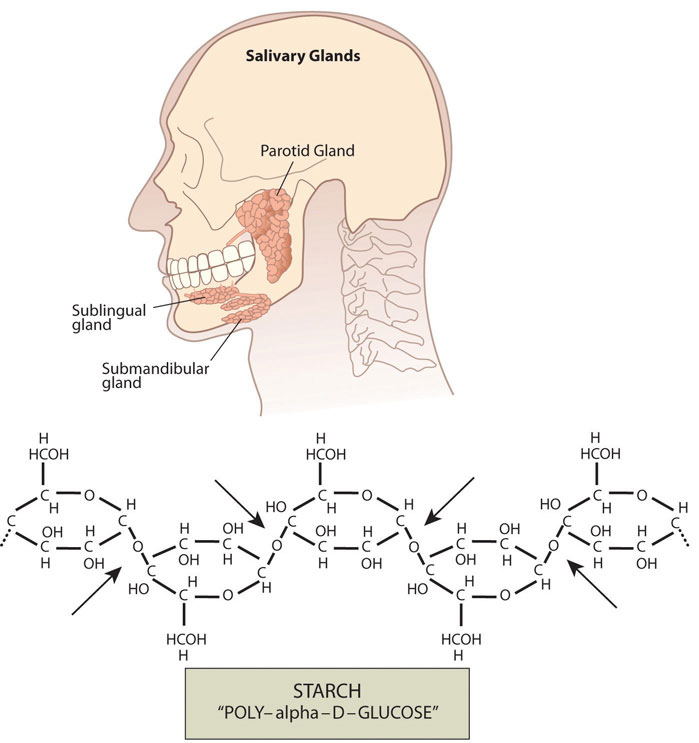
Salivary glands secrete salivary amylase, which begins the chemical breakdown of carbohydrates by breaking the bonds between monomeric sugar units. (Source: University of Hawaii @ Manoa, CC-BY-NC-SA)
From the Stomach to the Small Intestine
The chyme is gradually expelled into the upper part of the small intestine. Upon entry of the chyme into the small intestine, the pancreas releases pancreatic juice through a duct. This pancreatic juice contains the enzyme, pancreatic amylase, which starts again the breakdown of dextrins into shorter and shorter carbohydrate chains. Additionally, enzymes are secreted by the intestinal cells that line the villi. These enzymes, known collectively as disaccharidase, are sucrase, maltase, and lactase. Sucrase breaks sucrose into glucose and fructose molecules. Maltase breaks the bond between the two glucose units of maltose, and lactase breaks the bond between galactose and glucose. Once carbohydrates are chemically broken down into single sugar units they are then transported into the inside of intestinal cells.
Lactose Intolerance
When people do not have enough of the enzyme lactase, lactose is not sufficiently broken down resulting in a condition called lactose intolerance. The undigested lactose moves to the large intestine where bacteria are able to digest it. The bacterial digestion of lactose produces gases leading to symptoms of diarrhea, bloating, and abdominal cramps. Lactose intolerance usually occurs in adults and is associated with race. The National Digestive Diseases Information Clearing House states that African Americans, Hispanic Americans, American Indians, and Asian Americans have much higher incidences of lactose intolerance while those of northern European descent have the least.[1] Most people with lactose intolerance can tolerate some amount of dairy products in their diet. The severity of the symptoms depends on how much lactose is consumed and the degree of lactase deficiency.
Absorption: Going to the Blood Stream
The cells in the small intestine have membranes that contain many transport proteins in order to get the monosaccharides and other nutrients into the blood, where they can be distributed to the rest of the body. The liver is the first organ to receive glucose, fructose, and galactose. The liver takes them up and converts galactose to glucose, breaks fructose into even smaller carbon-containing units, and either stores glucose as glycogen or exports it back to the blood. How much glucose the liver exports to the blood is under hormonal control.
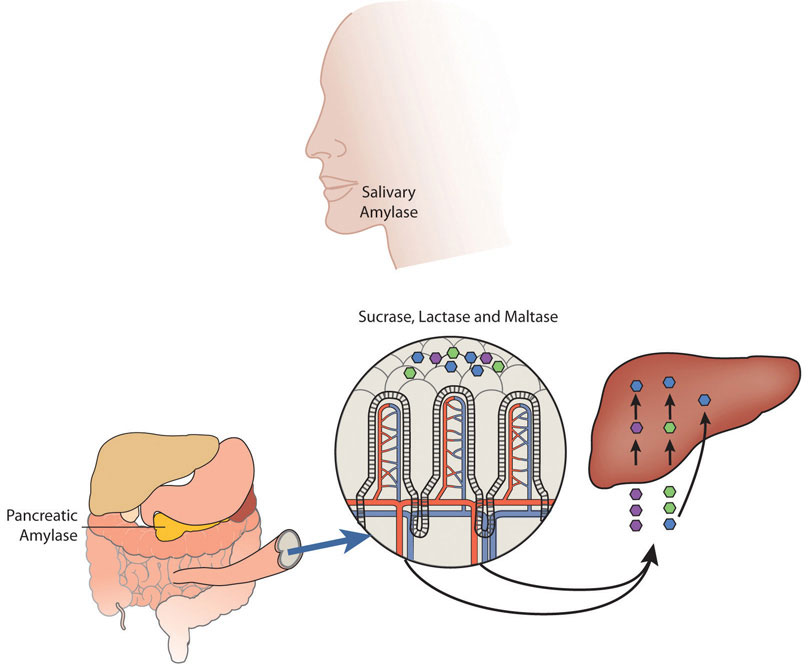
Carbohydrate digestion begins in the mouth and is most extensive in the small intestine. The resultant monosaccharides are absorbed into the bloodstream and transported to the liver. (Source: University of Hawaii @ Manoa, CC-BY-NC-SA)
Maintaining Blood Glucose Levels: The Pancreas and Liver
Glucose levels in the blood are tightly controlled, as having either too much or too little glucose in the blood can have health consequences. The glucose levels in the blood are regulated via a process called negative feedback. After eating a meal containing carbohydrates, glucose levels rise in the blood. Special cells in the pancreas sense the increase in blood glucose and release the hormone insulin into the blood. Insulin sends a signal to the body’s cells to remove glucose from the blood by transporting it into different organ cells around the body and using it to make energy. In the case of muscle tissue and the liver, insulin sends the biological message to store glucose away as glycogen. The presence of insulin in the blood signals to the body that glucose is available for fuel. As glucose is transported into the cells around the body, the blood glucose levels decrease.
Insulin has an opposing hormone called glucagon. Glucagon-secreting cells in the pancreas sense the drop in glucose and, in response, release glucagon into the blood. Glucagon communicates to the cells in the body to stop using all the glucose. More specifically, it signals the liver to break down glycogen and release the stored glucose into the blood, so that glucose levels stay within the target range and all cells get the needed fuel to function properly.
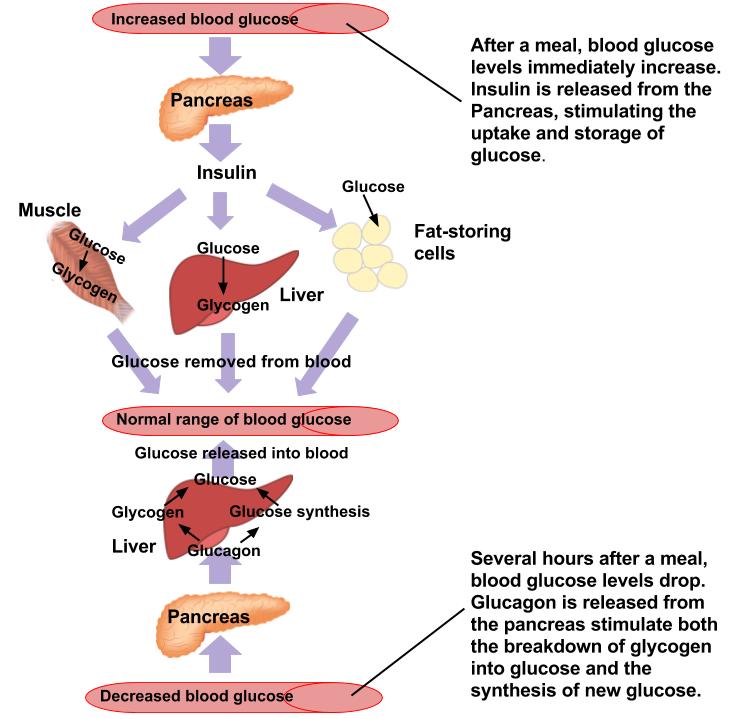
(Source: University of Hawaii @ Manoa, Allison Calabrese, CC-BY-NC-SA)
Leftover Carbohydrates: The Large Intestine
All of the carbohydrates, except for dietary fiber and resistant starches, are efficiently digested and absorbed into the body. Some of the remaining indigestible carbohydrates are broken down by enzymes released by bacteria in the large intestine. The products of bacterial digestion are short-chain fatty acids and some gases. The short-chain fatty acids are either used by the bacteria to make energy and grow, are eliminated in the feces, or are absorbed into cells of the colon, with a small amount being transported to the liver. Colonic cells use the short-chain fatty acids to support some of their functions. The liver can also metabolize the short-chain fatty acids into cellular energy. The yield of energy from dietary fiber is about 2 kilocalories per gram for humans, but is highly dependent upon the fiber type, with soluble fibers and resistant starches yielding more energy than insoluble fibers. Since dietary fiber is digested much less in the gastrointestinal tract than other carbohydrate types (simple sugars, many starches) the rise in blood glucose after eating them is less, and slower. These physiological attributes of high-fiber foods (i.e., whole grains) are linked to a decrease in weight gain and reduced risk of chronic diseases, such as Type 2 diabetes and cardiovascular disease.
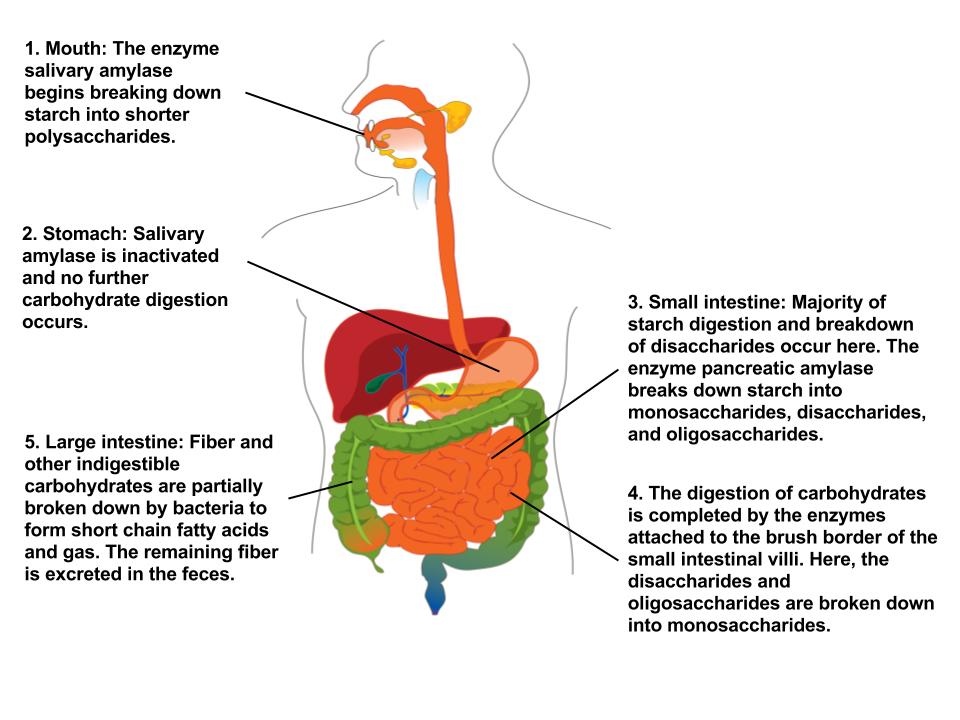
(Source: University of Hawaii @ Manoa, Allison Calabrese, CC-BY-NC-SA)
Glycemic Index
The glycemic index is a measure to determine the effect a food has on the glucose levels in the blood. Glucose levels in the blood rise after a person eats foods containing carbohydrates, and how much the glucose levels rise depends on the type of carbohydrate consumed. Factors that influence the glycemic index of a food include its nutrient composition, cooking method, ripeness, and the amount of processing it has undergone. Foods are classified as low (55 or less), medium (56 – 69), or high (70 or above) glycemic foods and are ranked on a scale of 0 – 100, where the lower the GI of a specific food, the less effect it has on glucose levels in the blood. Foods that have a low GI do not raise blood-glucose levels as much or as fast as foods that have a higher GI. A diet of low-GI foods has been shown in epidemiological and clinical trial studies to increase weight loss and reduce the risk of obesity, Type 2 diabetes, and cardiovascular disease.[2]
| Foods | GI Value |
|---|---|
| Apple, raw | 36 |
| Orange, raw | 43 |
| Banana, raw | 51 |
| Mango, raw | 51 |
| Carrots, boiled | 39 |
| Taro, boiled | 53 |
| Corn tortilla | 46 |
| Spaghetti (whole wheat) | 37 |
| Baked beans | 48 |
| Soy milk | 34 |
| Skim milk | 37 |
| Whole milk | 39 |
| Yogurt, fruit | 41 |
| Yogurt, plain | 14 |
| Ice cream | 51 |
| Foods | GI Value |
|---|---|
| Pineapple, raw | 59 |
| Cantaloupe | 65 |
| Mashed potatoes | 70 |
| Whole-wheat bread | 69 |
| Brown rice | 55 |
| Cheese pizza | 60 |
| Sweet potato, boiled | 63 |
| Macaroni and cheese | 64 |
| Popcorn | 65 |
| Foods | GI Value |
|---|---|
| Banana (over-ripe) | 82 |
| Corn chips | 72 |
| Pretzels | 83 |
| White bread | 70 |
| White rice | 72 |
| Bagel | 72 |
| Rice milk | 86 |
| Cheerios | 74 |
| Raisin Bran | 73 |
| Fruit roll-up | 99 |
| Gatorade | 78 |
The type of carbohydrate within a food affects the GI, along with its fat and fiber content. Increased fat and fiber in foods increases the time required for digestion and delays gastric emptying into the small intestine, ultimately reducing the GI. Processing and cooking also affect a food’s GI by increasing its digestibility. Advancements in food processing technologies and the high consumer demand for convenient, precooked foods in the United States have created foods that are digested and absorbed more rapidly, independent of the fiber content. Modern breakfast cereals, breads, pastas, and many prepared foods have a high GI. In contrast, most raw foods have a lower GI. (However, the more ripened a fruit or vegetable is, the higher its GI.)
The GI can be used as a guide for choosing healthier carbohydrate choices, but it has some limitations. The first is that GI does not consider the amount of carbohydrates in a portion of food, only the type of carbohydrate. Another is that combining low- and high-GI foods changes the GI for the meal. Also, some nutrient-dense foods have higher GIs than less nutritious foods. (For instance, oatmeal has a higher GI than chocolate because the fat content of chocolate is higher.) Lastly, meats and fats do not have a GI since they do not contain carbohydrates.
Learning Activities
Technology Note: The second edition of the Human Nutrition Open Educational Resource (OER) textbook features interactive learning activities. These activities are available in the web-based textbook and are not in downloadable versions (EPUB, Digital PDF, Print_PDF, or Open Document).
Learning activities may be used across various mobile devices; however, for the best user experience, it is strongly recommended that users complete these activities using a desktop or laptop computer.
- Lactose Intolerance. National Digestive Diseases Information Clearing House. http://digestive.niddk.nih.gov/ddiseases/pubs/lactoseintolerance/. Updated April 23, 2012. Accessed September 22, 2017. ↵
- Brand-Miller J, et al. (2009). Dietary Glycemic Index: Health Implications. Journal of the American College of Nutrition, 28(4), 446S–49S. https://www.ncbi.nlm.nih.gov/pubmed/20234031. Accessed August 12, 2025. ↵
A class of nutrients containing carbon, hydrogen, and oxygen atoms; most are commonly known as sugar, starches or dietary fibers.
An enzyme produced and secreted by the salivary glands that aids in the breakdown of starch into smaller units.
A form of starch composed of glucose units joined into unbranched chains.
Forms of starch composed of linked branched chains of glucose units.
A 6-carbon monosaccharide that is the major carbohydrate used to provide energy in the body.
A disaccharide made up of two glucose molecules linked together.
A mixture of partially digested food and gastric secretions in the stomach.
Fluid secreted by the pancreas that contains bicarbonate to neutralize stomach acid and enzymes for the digestion of macromolecules.
A disaccharide made of glucose linked to fructose and commonly known as table sugar.
A 6-carbon monosaccharide arranged in a ring structure that is found in fruits and honey.
A 6-carbon monosaccharide arranged in a ring structure part of the disaccharide lactose.
A disaccharide made of glucose linked to galactose found in milk.
A condition that results from the inability to digest lactose. Symptoms include bloating, gas, abdominal pain, discomfort, and diarrhea.
The storage form of a complex carbohydrate composed of multiple units of glucose linked together in a highly branched structure.
A hormone secreted by the pancreas in response to elevated blood glucose levels to transport glucose into the muscle or fat cells.
A hormone made in the pancreas that stimulates the breakdown of liver glycogen and the synthesis of glucose.
All carbohydrate related substances in food that is indigestible and excreted through the feces.

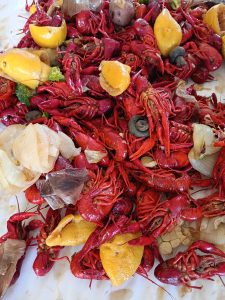 (Source:
(Source: 